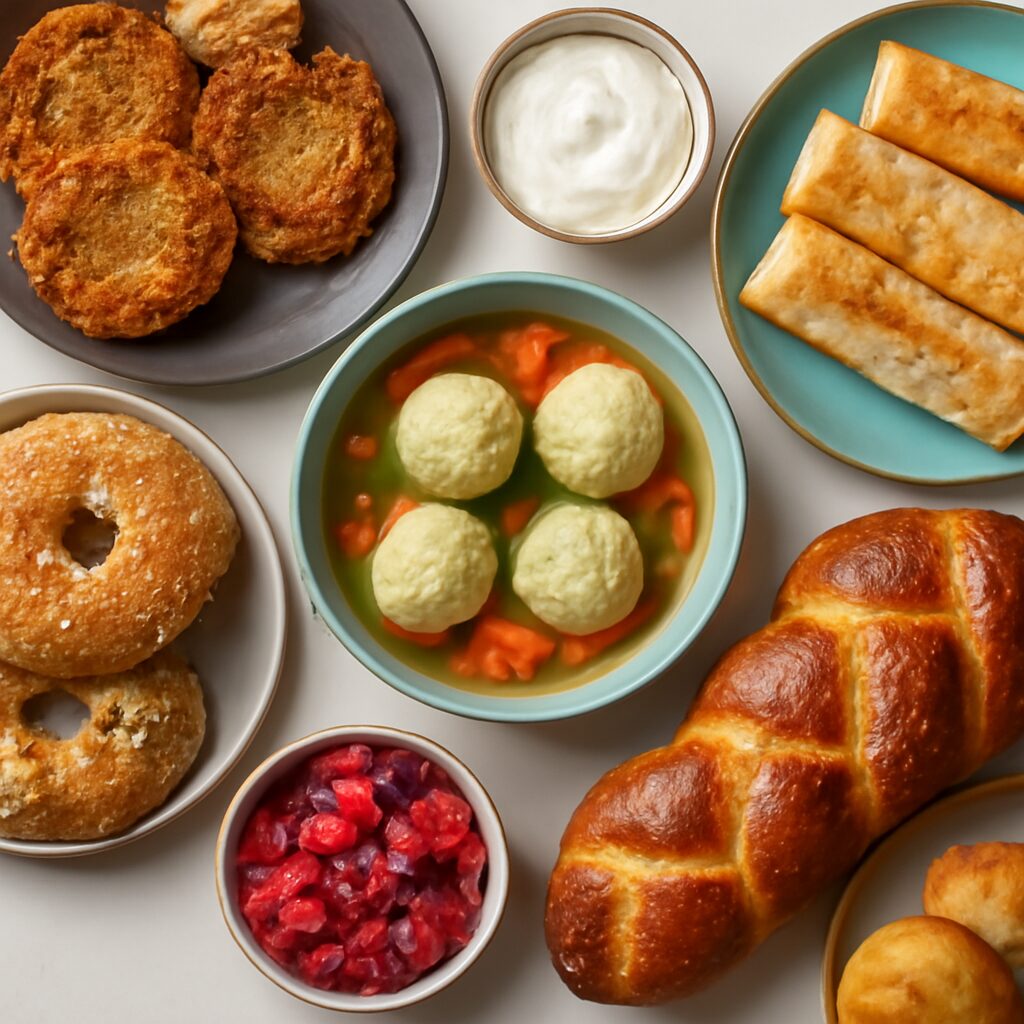
Jewish cuisine reflects a rich tapestry of history, culture, and tradition, shaped by centuries of migration and adaptation. From hearty Ashkenazi dishes to vibrant Sephardic flavors, these foods carry stories of resilience and community. This list highlights 50 of the most beloved Jewish foods, each with its own unique place at the table.
Jewish Food and Cuisine is incredibly diverse, reflecting the global journeys of the Jewish people. This list highlights 50 beloved Jewish foods from Ashkenazi (Eastern European), Sephardic (Mediterranean and North African), Mizrahi (Middle Eastern), and modern Israeli traditions. Each entry includes a brief description, its typical food category or occasion, and its origin.
Ashkenazi Cuisine (Eastern European Jewish Food)
1. Challah – A rich, soft braided egg bread traditionally served on Shabbat and Jewish holidays as the centerpiece of the meal. Category: Shabbat bread. Origin: Eastern Europe (Ashkenazi).
2. Bagel with Lox – Bakers boil and then bake a dense, ring-shaped yeast roll, often slicing it and smearing it with cream cheese before topping it with lox (cured salmon). It’s an iconic Jewish breakfast or brunch item, especially in diaspora communities. Many consider Smoked Salmon and Cream Cheese bagels the ultimate Jewish Food. Category: Everyday breakfast/deli food. Origin: Eastern Europe (Poland; popularized in American Jewish delis).
3. Chicken Soup with Matzo Balls – A flavorful chicken broth soup filled with matzo balls (dumplings made from matzah meal, eggs, and fat). People call chicken soup “Jewish penicillin” because it’s a comforting dish served on Shabbat and holidays. Category: Shabbat/holiday soup. Origin: Eastern Europe (Ashkenazi).
4. Gefilte Fish – Poached fish patties or quenelles made from a mixture of ground freshwater fish (like carp, pike, or whitefish) blended with eggs, matzo meal, and seasonings. Typically served cold as an appetizer with a dollop of horseradish. Category: Shabbat/Holiday appetizer (especially for Passover). Origin: Eastern Europe (Ashkenazi).
5. Brisket – A slow-braised beef brisket, cooked for hours until tender with onions, carrots, and spices. It yields a savory roast with rich gravy and is a staple at Ashkenazi holiday dinners (like Rosh Hashanah and Passover) and Shabbat meals. Category: Holiday/Shabbat main course. Origin: Eastern Europe (Ashkenazi).
6. Latkes – Crispy fried potato pancakes, often mixed with grated onion and egg, pan-fried in oil until golden. They are eaten especially during Hanukkah (to celebrate the oil miracle) and served with applesauce or sour cream. Category: Holiday food (Hanukkah). Origin: Eastern Europe (Ashkenazi).
7. Kugel – A baked pudding or casserole commonly made from either noodles (lokshen kugel) or grated potatoes (potato kugel). People make it sweet with egg noodles, cottage cheese, and raisins or savory with potatoes and onions, then serve it as a side dish on Shabbat and holidays. Category: Shabbat/holiday side dish. Origin: Eastern Europe (Ashkenazi).
8. Cholent – A hearty slow-cooked stew of meat, beans, potatoes, and barley. Prepared before Shabbat and left to cook overnight, it results in a rich, tender stew for Saturday lunch. (Sephardic Jews have a similar hamin or dafina with regional variations.) Category: Shabbat food (stew). Origin: Eastern Europe (Ashkenazi).

9. Stuffed Cabbage (Holishkes) – Cabbage leaves rolled around a filling of ground beef, rice, and spices, then simmered in a sweet-and-sour tomato sauce. Often served on Sukkot or Simchat Torah, but also a comfort food at family dinners year-round. Category: Holiday dish / comfort food. Origin: Eastern Europe (Ashkenazi).
10. Knish – A savory pastry snack consisting of mashed potato (sometimes mixed with fried onions or kasha) or spiced meat encased in a dough pocket. Street vendors and bakeries, especially in New York’s Jewish communities, bake or fry knishes and sell them. Category: Snack (street food). Origin: Eastern Europe (Ashkenazi).
11. Blintzes – Thin crêpe-like pancakes filled with sweet farmer’s cheese (or sometimes fruit fillings), rolled up and lightly pan-fried in butter. People often top cheese blintzes with sour cream or jam and enjoy them as a Jewish food on Shavuot or as a dessert. Category: Dairy dish / dessert (Shavuot treat). Origin: Eastern Europe (Ashkenazi).
12. Rugelach – Bite-sized rolled pastries made from a cream-cheese or sour-cream dough, filled with sweet fillings such as cinnamon-sugar with nuts, chocolate, or apricot jam. Bakers roll rugelach into crescent shapes and bake them until flaky. Category: Dessert pastry (cookie). Origin: Eastern Europe (Ashkenazi).
13. Babka – A sweet, yeast-raised cake-bread swirled with ribbons of chocolate, cinnamon, or nuts. Bakers roll the dough with filling, twist it before baking, and create a marbled loaf. People often enjoy babka with coffee or as a Shabbat dessert. Category: Dessert bread/cake. Origin: Eastern Europe (Ashkenazi).
14. Hamantaschen – Triangular three-cornered cookies traditionally eaten during Purim. Bakers fold dough around a sweet filling like poppy seed paste (mohn), prune or apricot lekvar, or fruit preserves. The triangular shape represents Haman’s hat or ears. Category: Holiday food (Purim dessert). Origin: Eastern Europe (Ashkenazi).
15. Tzimmes – A slow-cooked sweet stew typically made of carrots and dried fruits like prunes or apricots (sometimes with sweet potatoes or chunks of meat). Cooks often flavor it with honey and cinnamon and serve it as a side dish, especially at Rosh Hashanah for a sweet new year. Category: Holiday side dish. Origin: Eastern Europe (Ashkenazi).
16. Chopped Liver – A rich pâté-style spread made from chicken or beef liver sautéed with onions and hard-boiled eggs, then minced. Jews traditionally serve it as an appetizer on rye bread or crackers, especially at Shabbat dinners and delicatessens. Category: Appetizer spread. Origin: Eastern Europe (Ashkenazi).
17. Pastrami on Rye – An iconic Jewish deli sandwich. Chefs thinly slice pastrami (beef brisket that’s been brined, spiced, smoked, and steamed) and pile it high on rye bread spread with mustard. It became famous in New York delis but has roots in Romanian Jewish preparation of preserved meat. Category: Deli sandwich (everyday lunch). Origin: Eastern Europe (Romania, via American Jewish delis).
18. Pickled Herring – Fillets of herring cured in a brine of vinegar, salt, and often onions, sometimes with a touch of sugar or spices. People commonly serve this tangy fish delicacy as an appetizer or part of a kiddush (post-synagogue gathering), often alongside black bread or crackers. Category: Appetizer (Shabbat and celebration food). Origin: Eastern Europe (Ashkenazi).
19. Matzah (Matzo) – An unleavened flatbread cracker eaten during the Passover holiday. Bakers mix flour and water, then bake it quickly to prevent rising, symbolizing the bread that didn’t have time to rise during the Israelites’ exodus. Matzah is central to the Passover Seder plate and meals throughout the week of Passover. Category: Holiday staple (Passover bread). Origin: Ancient Middle East (biblical tradition, observed across Jewish communities).
20. Matzo Brei – A Passover comfort breakfast made by breaking matzah into pieces, soaking them in water or milk, then frying with beaten egg (similar to scrambled eggs or a pancake). Matzo Brei is served sweet (with cinnamon and sugar or jam) or savory (with salt and pepper). Category: Passover breakfast, Pesach Jewish Food. Origin: Eastern Europe (Ashkenazi).
21. Kasha Varnishkes – A warm buckwheat (kasha) and noodle dish. Bow-tie pasta (farfalle) is cooked with toasted buckwheat groats, caramelized onions, and oil or schmaltz. It’s a savory side dish that’s quintessential Ashkenazi comfort food, often served at Shabbat or holiday meals. Category: Side dish. Origin: Eastern Europe (Ashkenazi).
22. Kreplach – Small triangular dumplings filled with seasoned ground beef or chicken (or sometimes potato). They resemble mini ravioli or wontons. Kreplach are traditionally simmered in chicken soup or fried and served during certain occasions (eaten before Yom Kippur, on Hoshana Rabbah, and Purim). Category: Holiday food (soup dumplings or fried treat). Origin: Eastern Europe (Ashkenazi).
23. Honey Cake (Lekach) – A moist spiced cake sweetened with honey, often containing warm spices like cinnamon and clove. It is traditionally baked for Rosh Hashanah to ensure a sweet new year. Many families have cherished recipes for honey cake, making it a nostalgic holiday dessert. Category: Holiday dessert (Rosh Hashanah). Origin: Eastern Europe (Ashkenazi).
Sephardic Cuisine (Mediterranean & North African Jewish Food)
24. Sephardic Hamin (Dafina) – A fragrant overnight stew equivalent to Ashkenazi cholent. Sephardic versions (like Moroccan dafina or Spanish adafina) include beef or lamb, chickpeas, beans, whole eggs, and spices such as cumin and turmeric. It’s slow-cooked from before sundown Friday until Saturday lunch, resulting in a flavorful one-pot Shabbat meal. Category: Shabbat stew. Origin: Iberian/North African Sephardic communities.
25. Couscous with Vegetable Stew – Steamed couscous (tiny semolina granules) served under a hearty stew of vegetables, spices, and often meat or chicken. This dish is a staple among North African Jews (e.g., Moroccan, Tunisian) for Shabbat lunch or weekday dinners. The fluffy couscous soaks up spiced broth from stewed carrots, zucchini, pumpkin, and chickpeas. Category: Everyday staple / Shabbat meal. Origin: North Africa (Moroccan Jewish cuisine).
26. Chraime – A spicy fish dish popular among Moroccan, Libyan, and Tunisian Jews. It features fish steaks (such as cod, snapper, or halibut) simmered in a thick tomato sauce spiked with garlic, paprika, cumin, and chili pepper. Chraime is often served as a first course on Shabbat or at festive meals, accompanied by bread to mop up the piquant sauce. Category: Shabbat/holiday main (fish). Origin: North Africa (Sephardic Maghrebi).
27. Stuffed Grape Leaves – Also known as dolmas or yaprach, these are grape vine leaves wrapped around a filling of rice, herbs, and sometimes ground beef or lamb. Sephardic Jews from regions like Turkey, Greece, and the Middle East prepare them as appetizers or sides. They can be served cold (often meatless and lemony) or warm in a savory sauce. Category: Appetizer/mezze. Origin: Mediterranean (Ottoman Empire, adopted by Sephardic communities).
28. Fried Artichokes (Carciofi alla Giudia) – A famous specialty of Rome’s Jewish ghetto. Whole artichokes are flattened and deep-fried in olive oil until the leaves turn crispy and golden, resembling a flower. Sprinkled with salt and lemon, these artichokes are traditionally enjoyed during the spring (around Passover time) and showcase the Italian-Jewish culinary heritage. Category: Appetizer or side dish. Origin: Italy (Roman Jewish cuisine).
29. Bourekas – Savory flaky pastries brought to Israel by Sephardic immigrants from Turkey and the Balkans. Bourekas are a Jewish Food made of puff pastry or phyllo dough and stuffed with fillings like salty cheese, mashed potato, spinach, or eggplant. They are baked to a golden brown and often sprinkled with sesame seeds. Commonly found in Israeli bakeries and markets, they’re enjoyed as street food or party snacks. Category: Snack / street food (savory pastry). Origin: Ottoman Empire (Sephardic Jewish communities in Turkey and the Balkans).
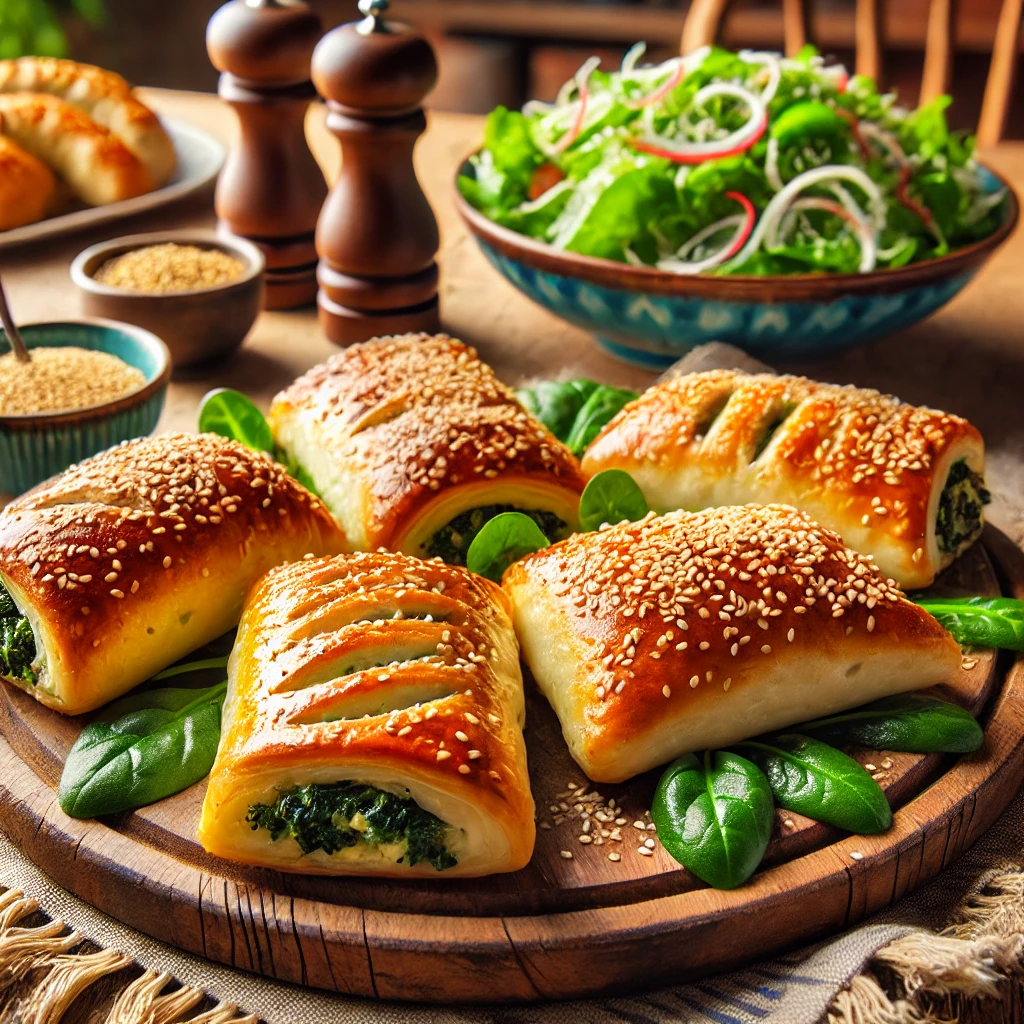
30. Baklava – A luscious dessert of the Ottoman origin beloved by many Sephardic Jews. Baklava is made of many layers of thin filo dough filled with finely chopped nuts (such as pistachios or walnuts) and soaked in a syrup or honey after baking. It’s exceedingly sweet and often flavored with rosewater or orange blossom water. Sephardic Jews serve baklava and similar nut pastries on special occasions and holidays. Category: Dessert. Origin: Middle East (Ottoman Empire, adopted in Sephardic cuisine).
31. Mofletta – A thin, crepe-like pancake traditionally prepared by Moroccan Jews at the end of Passover. Made from a simple dough of flour, water, and oil, moflettas are cooked in a pan and then spread with butter, honey, or jam. They are the centerpiece of the Mimouna celebration (a post-Passover festivity), symbolizing welcome and abundance once leavened foods are permitted again. Category: Holiday food (Mimouna festival treat). Origin: Morocco (Sephardic).
32. Charoset – A sweet, chunky paste of fruits and nuts made for the Passover Seder. Ingredients vary by community: Ashkenazi Jews use chopped apples, walnuts, sweet wine, and cinnamon, while Sephardic recipes might include dates, raisins, figs, almonds, and wine to create a dark fruity spread. Eaten on matzah during the Seder, charoset represents the mortar used by Hebrew slaves in Egypt. Category: Holiday food (Passover ritual dish). Origin: Ancient Israel (with diverse Diaspora variations).
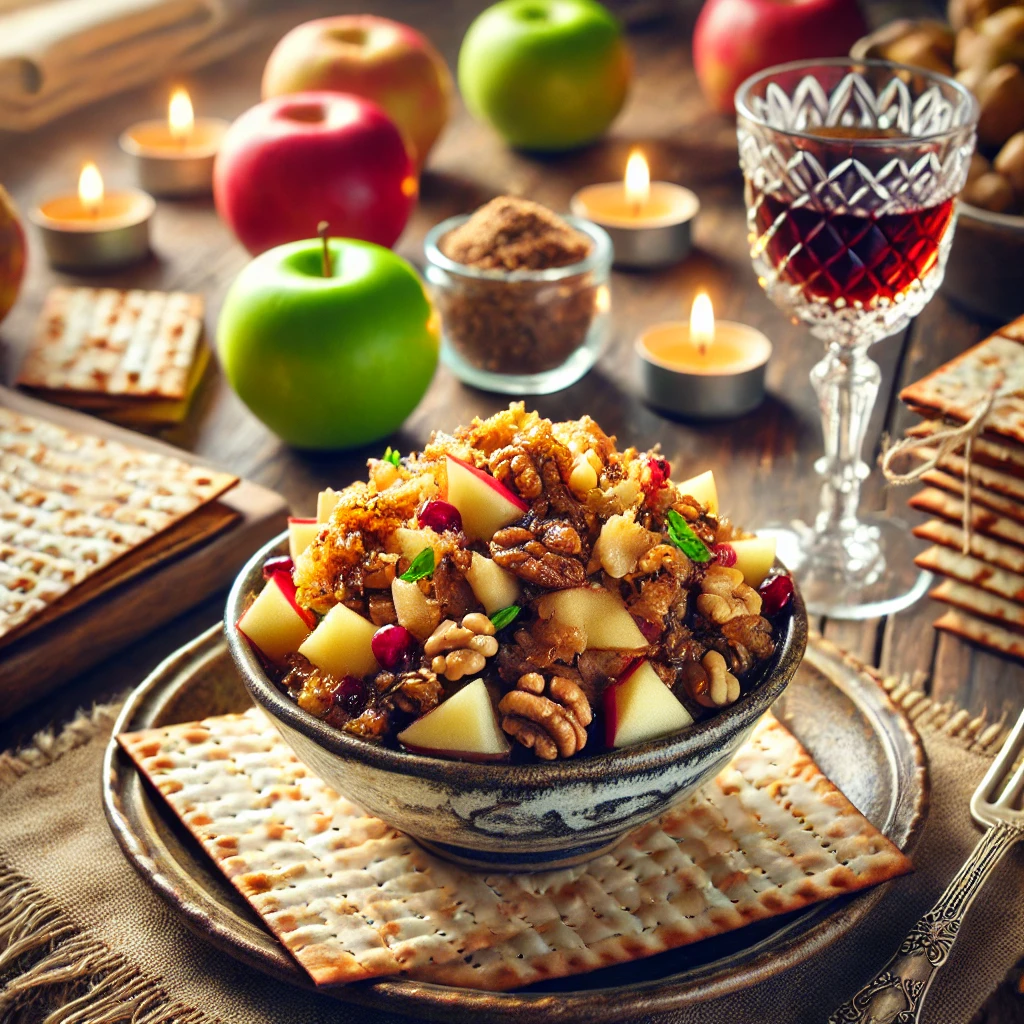
Mizrahi Cuisine (Middle Eastern Jewish Foods)
33. Kubaneh – A buttery yeast bread traditionally baked overnight in a covered pot for Shabbat morning by Yemenite Jews. Kubaneh yields pull-apart rolls or loaf with a rich, brioche-like texture. This Jewish Food is often eaten warm for breakfast on Sabbath, accompanied by spreads like grated tomato, zhug (spicy herb sauce), or butter. Category: Shabbat bread. Origin: Yemen (Mizrahi).
34. Jachnun – A Yemenite Jewish Food specialty of rolled dough sheets. The dough is spread with clarified butter (or schmaltz), rolled tight, and baked at a low heat overnight. The result is a dark brown, flaky roll with a slightly sweet, caramelized taste. Jachnun is traditionally served on Shabbat morning along with crushed tomato sauce, hard-boiled eggs, and skhug (hot sauce). Category: Shabbat morning food. Origin: Yemen (Mizrahi).
35. Malawach – A Yemenite Jewish fried flatbread. Malawach comes as a flat, round, layered dough that’s pan-fried until golden and flaky, somewhat like a thick pancake made of many thin layers. It can be eaten savory (with fresh grated tomato, boiled egg, and hot sauce) or sweet (drizzled with honey or syrup). Malawach is enjoyed in Israel as a street food or breakfast item, reflecting the Yemenite influence on Israeli cuisine. Category: Everyday bread/flatbread. Origin: Yemen (Mizrahi).
36. Yemenite Chicken Soup – A hearty soup from the Yemenite Jewish tradition, distinguished by its use of hawaij – a Yemenite spice blend (often containing turmeric, cumin, cardamom, and coriander). The soup typically includes slow-cooked chicken pieces, onions, tomato, and sometimes root vegetables, and is served with hilbeh (a fenugreek-based dip) and flatbreads like lahoh. It’s known for its deep golden color and spicy, aromatic flavor. Category: Everyday/Shabbat soup. Origin: Yemen (Mizrahi).
37. Gondi – A traditional Persian-Jewish dish of meatballs or dumplings made from ground chicken or veal mixed with chickpea flour, onions, and Persian spices like cardamom. The dumplings are cooked in a chicken broth, yielding a soup often served on Shabbat. Gondi have a firm, matzo ball-like texture and are usually served as a starter, garnished with fresh herbs and a squeeze of lemon. Category: Shabbat soup (dumplings). Origin: Iran (Persian Jewish cuisine).
38. Kibbeh (Kubbeh) – A family of Middle Eastern dishes enjoyed by Jewish communities from Syria, Lebanon, Iraq, and beyond. The most common form is a torpedo-shaped fried croquette: a crispy bulgur wheat shell filled with spiced ground meat and pine nuts. Another popular version is kubbeh soup, like kubbeh adom (red beet soup with beef-filled semolina dumplings) or kubbeh hamusta (sour green soup). Kibbeh are often served as appetizers or in soup for festive meals. Category: Appetizer or soup dumpling. Origin: Middle East (Levant and Iraqi Jewish traditions).

Modern Israeli Cuisine
39. Falafel – Arguably Israel’s most famous street food: deep-fried balls of ground chickpeas (sometimes with fava beans) mixed with herbs like parsley and cilantro. Falafel balls are crispy on the outside and tender inside. They are typically stuffed into a pita bread with salads, pickles, and drizzles of tahini sauce or amba (tangy mango sauce). Category: Street food (sandwich). Origin: Middle East (likely Egypt or Levant, adopted as a national dish of Israel).
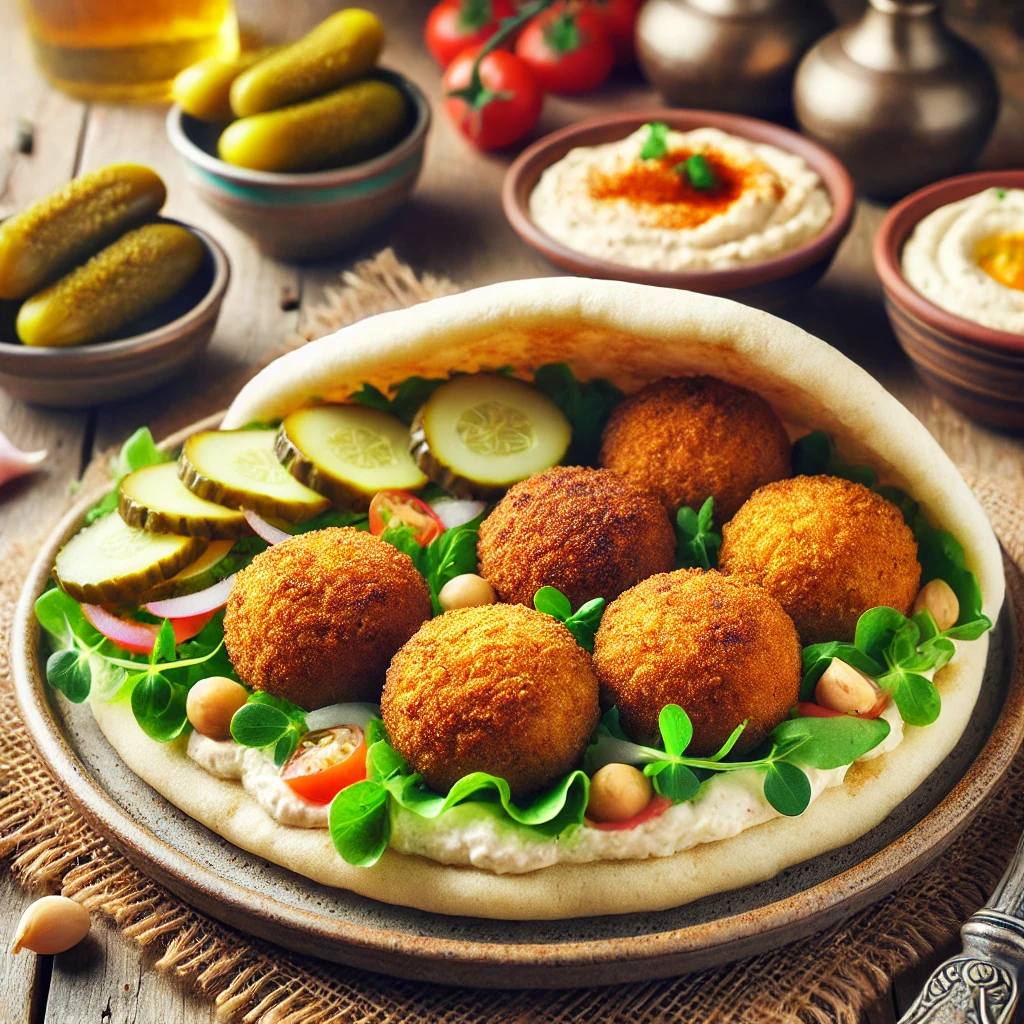
40. Hummus – A creamy spread or dip made from pureed chickpeas blended with tahini (sesame paste), lemon juice, garlic, and salt. A staple across the Middle East, hummus is also a cornerstone of Israeli cuisine. It’s commonly served as part of a mezze or as a meal unto itself (topped with olive oil, paprika, whole chickpeas or fava beans) and scooped up with warm pita bread. Category: Mezze dip / everyday staple. Origin: Middle East (Levantine Arab origin, embraced in Israeli diet).
41. Shawarma – Spit-roasted slices of marinated meat, most often turkey, chicken, or lamb, carved from a rotating skewer. The juicy meat is wrapped in a pita or laffa (flatbread) and loaded with Israeli salad, tahini or garlic sauce, pickles, and fries. Shawarma stands are ubiquitous in Israel, making this originally Middle Eastern dish a go-to street food. Category: Street food (wrap). Origin: Middle East (Ottoman Empire), popular in modern Israel.
42. Sabich – An Israeli-Iraqi sandwich known for its unique combination of ingredients. Sabich is a pita stuffed with fried eggplant slices, hard-boiled egg (often seasoned with warm spices), hummus, tahini, Israeli salad, pickles, and amba (mango chutney). It was introduced by Iraqi Jewish immigrants and was traditionally a breakfast food on Shabbat morning (using leftovers). Now it’s a beloved Israeli street food available all week. Category: Street food (sandwich). Origin: Iraq (Jewish), adopted in Israel.
43. Arayes – A newer star in Israeli street food, arayes are pitas that have been spread on the inside with spiced ground meat (usually lamb or beef mixed with parsley, garlic, and spices), then grilled over charcoal. The pita gets crispy and smoky, and the meat inside cooks juicy. Served cut into quarters, arayes make a satisfying snack or appetizer, often accompanied by tahini or tomato dip. Category: Street food / appetizer. Origin: Levant (popularized in Israel).
44. Jerusalem Mixed Grill – A hearty street-food dish invented in the Mahane Yehuda market of Jerusalem. It consists of a mix of grilled organ meats – typically chicken hearts, livers, and spleen – seasoned with onions, garlic, and a blend of Middle Eastern spices like cumin and turmeric. The Jewish Food mixture is fried on a flat grill and commonly served in a pita with salads. It’s a flavorful homage to nose-to-tail cooking in Israeli cuisine. Category: Street food (meat specialty). Origin: Israel (Jerusalem).
45. Shakshuka – A vibrant dish of eggs poached in a spiced tomato and bell pepper sauce. Originating in North Africa, shakshuka has become a breakfast and brunch staple in Israel. The sauce usually includes onions, garlic, paprika, and chili pepper, and the eggs are cooked until just set. It’s served straight from the pan, often with bread to soak up the rich sauce. Category: Everyday meal (breakfast/brunch). Origin: North Africa (Tunisian/Libyan), popularized in Israeli cuisine.
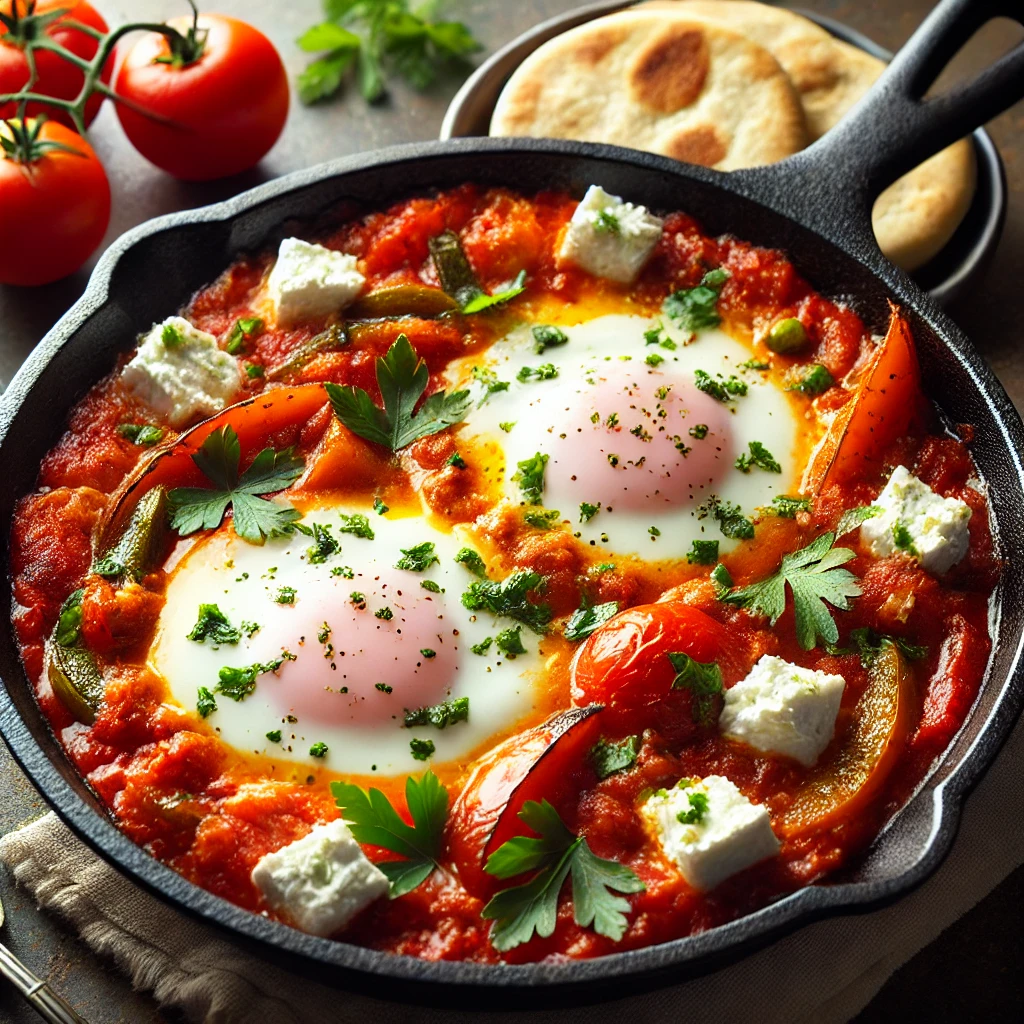
46. Israeli Schnitzel – A local take on the breaded cutlets of Europe. Brought by Ashkenazi immigrants, schnitzel in Israel is typically made with pounded chicken breasts (rather than veal) coated in breadcrumbs (sometimes matzah meal) and fried until golden. It’s a very common homemade meal, often paired with mashed potatoes, rice, or chips, and a squeeze of lemon. Category: Everyday main course. Origin: Central Europe (via Israel).
47. Israeli Salad – A simple yet ubiquitous side dish in Israel made from finely chopped tomatoes and cucumbers, dressed with olive oil, lemon juice, salt, and sometimes chopped parsley or mint. It’s served at just about every meal – as part of breakfast spreads, alongside mains, in falafel and shawarma pitas, etc. This salad, also known as Arab or Middle Eastern salad, reflects the agricultural freshness of Israeli produce. Category: Side dish. Origin: Levant (adopted into Israeli cuisine).
48. Ptitim (Israeli Couscous) – Also nicknamed “Ben-Gurion rice,” ptitim are small pearl-like toasted pasta beads. They were developed in the 1950s in Israel as an affordable substitute for rice. Cooked by boiling or sautéing like pasta, ptitim have a springy texture and a mild, nutty flavor from the toasting. They are often served as a simple side dish or mixed into salads for a quick weekday meal. Category: Everyday side (pasta). Origin: Israel.
49. Malabi – A silky, milk-based pudding dessert, often thickened with cornstarch. Malabi (related to the Turkish muhallebi) is served cold and topped with a sweet syrup typically flavored with rosewater or pomegranate, plus garnishes like crushed pistachios or coconut. Sold by street vendors and restaurants alike, it’s a refreshing sweet finish to a meal in Israel. Category: Dessert. Origin: Middle East (Ottoman/Turkish dessert, popular in Israel).
50. Sufganiyot – Soft, pillowy doughnuts traditionally eaten in Israel during Hanukkah. Sufganiyot are deep-fried treats (honoring the oil theme of the holiday) and filled with jelly or jam, then dusted with powdered sugar. While fried doughnuts have European roots, in modern Israel these jelly doughnuts have largely replaced latkes as the most popular Hanukkah indulgence, with bakeries inventing creative fillings each year. My personal favorite Jewish Food Category: Holiday food (Hanukkah dessert). Origin: Israel (modern adaptation of European-style jelly doughnuts).



